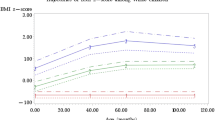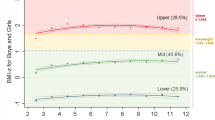Abstract
Objective
The aims of this study are to describe growth trajectories in the body mass index (BMI) among the major racial and ethnic groups of US children and to identify predictors of children’s BMI trajectories.
Methods
The Early Childhood Longitudinal Study-Birth Cohort (ECLS-B) was used to identify predictors of BMI growth trajectories, including child characteristics, maternal attributes, home practices related to diet and social behaviors, and family sociodemographic factors. Growth models, spanning 48 to 72 months of age, were estimated with hierarchical linear modeling via STATA/Xtmixed methods.
Results
Approximately one-third of 4-year-old females and males were overweight and/or obese. African-American and Latino children displayed higher predicted mean BMI scores and differing mean BMI trajectories, compared with White children, adjusting for time-independent and time-dependent predictors. Several factors were significantly associated with lower mean BMI trajectories, including very low birth weight, higher maternal education level, residing in a two-parent household, and breastfeeding during infancy. Greater consumption of soda and fast food was associated with higher mean BMI growth. Soda consumption was a particularly strong predictor of mean BMI growth trajectory for young Black children. Neither the child’s inactivity linked to television viewing nor fruit nor vegetable consumption was predictive of BMI growth for any racial/ethnic group.
Conclusion
Significant racial and ethnic differences are discernible in BMI trajectories among young children. Raising parents’ and health practitioners’ awareness of how fast food and sweetened-beverage consumption contributes to early obesity and growth in BMI—especially for Blacks and Latinos—could improve the health status of young children.

Similar content being viewed by others
References
Ogden CL, Carroll MD, Flegal KM. High body mass index for age among US children and adolescents, 2003-2006. JAMA. 2008;299(20):2401–5.
Anderson SE, Whitaker RC. Prevalence of obesity among US preschool children in different racial and ethnic groups. Arch Pediatr Adolesc Med. 2009;163(4):344–8.
Singh GK et al. Racial/ethnic, socioeconomic, and behavioral determinants of childhood and adolescent obesity in the United States: analyzing independent and joint associations. Ann Epidemiol. 2008;18(9):682–95.
Taveras EM et al. Racial/ethnic differences in early-life risk factors for childhood obesity. Pediatrics. 2010;125(4):686–95.
Taveras EM et al. Reducing racial/ethnic disparities in childhood obesity: the role of early life risk factors. JAMA Pediatr. 2013;167(8):731–8.
Anderson SE, Whitaker RC. Household routines and obesity in US preschool-aged children. Pediatrics. 2010;125(3):420–8.
Burdette HL, Whitaker RC. A national study of neighborhood safety, outdoor play, television viewing, and obesity in preschool children. Pediatrics. 2005;116(3):657–62.
Shankaran S et al. Risk for obesity in adolescence starts in early childhood. J Perinatol. 2011;31:711–6.
Li N et al. Is there a healthy foreign born effect for childhood obesity in the United States? Matern Child Health J. 2011;15(3):310–23.
Nevarez MD et al. Associations of early life risk factors with infant sleep duration. Acad Pediatr. 2010;10(3):187–93.
Patrick H, Nicklas TA. A review of family and social determinants of children’s eating patterns and diet quality. J Am Coll Nutr. 2005;24(2):83–92.
Birch LL, Davison KK. Family environmental factors influencing the developing behavioral controls of food intake and childhood overweight. Pediatr Clin N Am. 2001;48(4):893–907.
Larson NI et al. Fruit and vegetable intake correlates during the transition to young adulthood. Am J Prev Med. 2008;35(1):33–7.
Li C et al. Developmental trajectories of overweight during childhood: role of early life factors. Obesity (Silver Spring). 2007;15(3):760–71.
Lee JM et al. Body mass index and timing of pubertal initiation in boys. Arch Pediatr Adolesc Med. 2010;164(2):139–44.
Kyle Snow LT, Derecho A, Wheeless S, Lennon J, Kinsey S, Rogers J, et al. User’s manual for the ECLS-B longitudinal 9-month--preschool restricted-use data file and electronic codebook. Washington, DC: National Center for Education Statistics; 2007.
Garg A, Toy S, Tripodis Y, Cook J, Cordella N. Influence of maternal depression on household food insecurity for low-income families. Acad Pediatr. 2015;15(3):305–10.
Surkan PJ et al. Early maternal depressive symptoms and child growth trajectories: a longitudinal analysis of a nationally representative US birth cohort. BMC Pediatr. 2014;14:185.
Gibbs BG, Forste R. Socioeconomic status, infant feeding practices and early childhood obesity. Pediatr Obes. 2014;9(2):135–46.
Ruzek E et al. The quality of toddler child care and cognitive skills at 24 months: propensity score analysis results from the ECLS-B. Early Child Res Q. 2014;28(1).
National Center for Education Statistics. Early childhood longitudinal study, birth cohort (ECLS-B) psychometric report for 2-year data collection. 2007 [cited 2015 April 9]; Available from: https://nces.ed.gov/pubsearch/pubsinfo.asp?pubid=2007084.
Roy SM et al. Body Mass Index (BMI) trajectories in infancy differ by population ancestry and may presage disparities in early childhood obesity. J Clin Endocrinol Metab. 2015;100(4):1551–60.
Moss BG, Yeaton WH. Young children’s weight trajectories and associated risk factors: results from the Early Childhood Longitudinal Study-Birth Cohort. Am J Health Promot. 2011;25(3):190–8.
Gable S, Chang Y, Krull JL. Television watching and frequency of family meals are predictive of overweight onset and persistence in a national sample of school-aged children. J Am Diet Assoc. 2007;107(1):53–61.
Balistreri KS, Van Hook J. Trajectories of overweight among US school children: a focus on social and economic characteristics. Matern Child Health J. 2011;15(5):610–9.
Fiorito LM et al. Girls’ early sweetened carbonated beverage intake predicts different patterns of beverage and nutrient intake across childhood and adolescence. J Am Diet Assoc. 2010;110(4):543–50.
Harris KM, Perreira KM, Lee D. Obesity in the transition to adulthood: predictions across race/ethnicity, immigrant generation, and sex. Arch Pediatr Adolesc Med. 2009;163(11):1022–8.
Cecil-Karb R, Grogan-Kaylor A. Childhood body mass index in community context: neighborhood safety, television viewing, and growth trajectories of BMI. Health Soc Work. 2009;34(3):169–77.
Nonnemaker JM et al. Youth BMI trajectories: evidence from the NLSY97. Obesity (Silver Spring). 2009;17(6):1274–80.
Morrissey TW, Dunifon RE, Kalil A. Maternal employment, work schedules, and children’s body mass index. Child Dev. 2011;82(1):66–81.
Iriart C et al. Obesity and malnutrition among Hispanic children in the United States: double burden on health inequities. Rev Panam Salud Publica. 2013;34(4):235–43.
Carroll-Scott A et al. Disentangling neighborhood contextual associations with child body mass index, diet, and physical activity: the role of built, socioeconomic, and social environments. Soc Sci Med. 2013;95:106–14.
Balistreri KS, Van Hook J. Socioeconomic status and body mass index among Hispanic children of immigrants and children of natives. Am J Public Health. 2009;99(12):2238–46.
Lim S et al. Obesity and sugar-sweetened beverages in African-American preschool children: a longitudinal study. Obesity (Silver Spring). 2009;17(6):1262–8.
Acknowledgments
We would like to thank Anthony Kim and Lynna Chu for their assistance in the preparation of this manuscript. This study was funded by grant R40 MC 21517 from the US Department of Health and Human Services, Health Resources and Services Administration, Maternal and Child Health Research Program (PI: Dr. Guerrero). Drs. Fuller and Bridges are supported in part by the University of California’s Institute of Human Development and the McCormick Foundation.
Compliance with Ethical Standards
All authors have approved the manuscript as submitted and with the exception of the funding mentioned in the Acknowledgements section, author Guerrero, author Mao, author Fuller, author Bridges, author Franke, and author Kuo do not have any conflicts of interest to declare for the past three years dating from the month of this submission.
Author information
Authors and Affiliations
Corresponding author
Rights and permissions
About this article
Cite this article
Guerrero, A.D., Mao, C., Fuller, B. et al. Racial and Ethnic Disparities in Early Childhood Obesity: Growth Trajectories in Body Mass Index. J. Racial and Ethnic Health Disparities 3, 129–137 (2016). https://doi.org/10.1007/s40615-015-0122-y
Received:
Revised:
Accepted:
Published:
Issue Date:
DOI: https://doi.org/10.1007/s40615-015-0122-y




